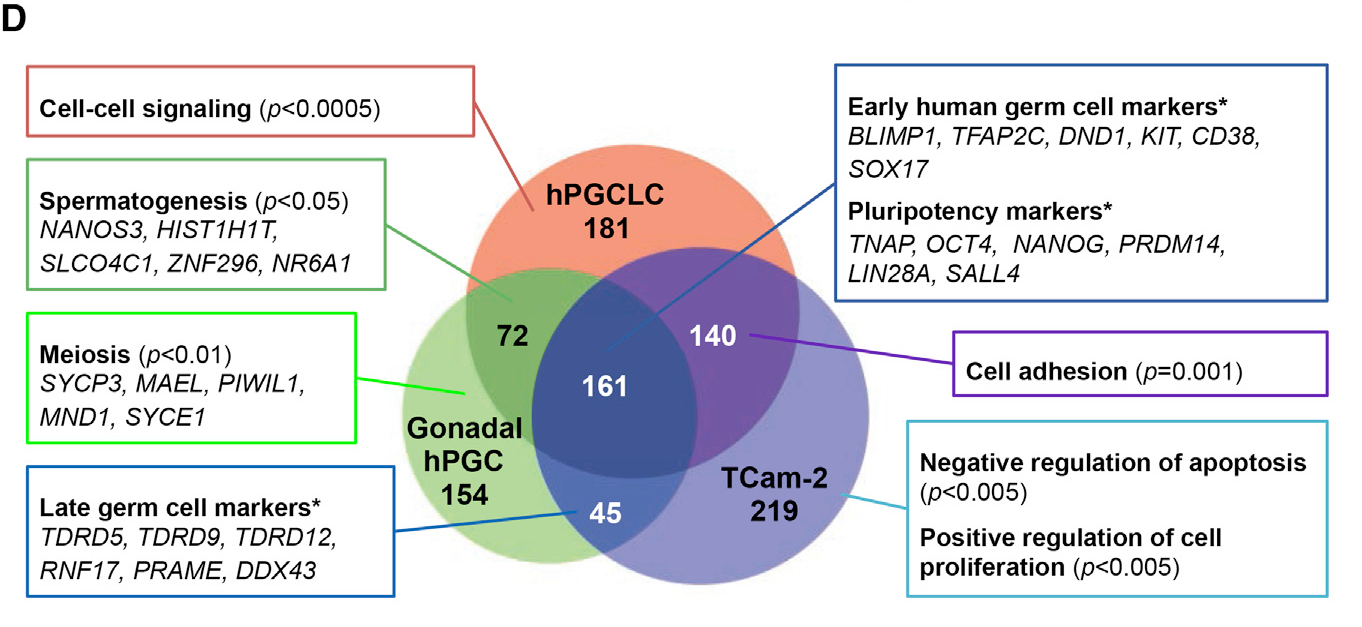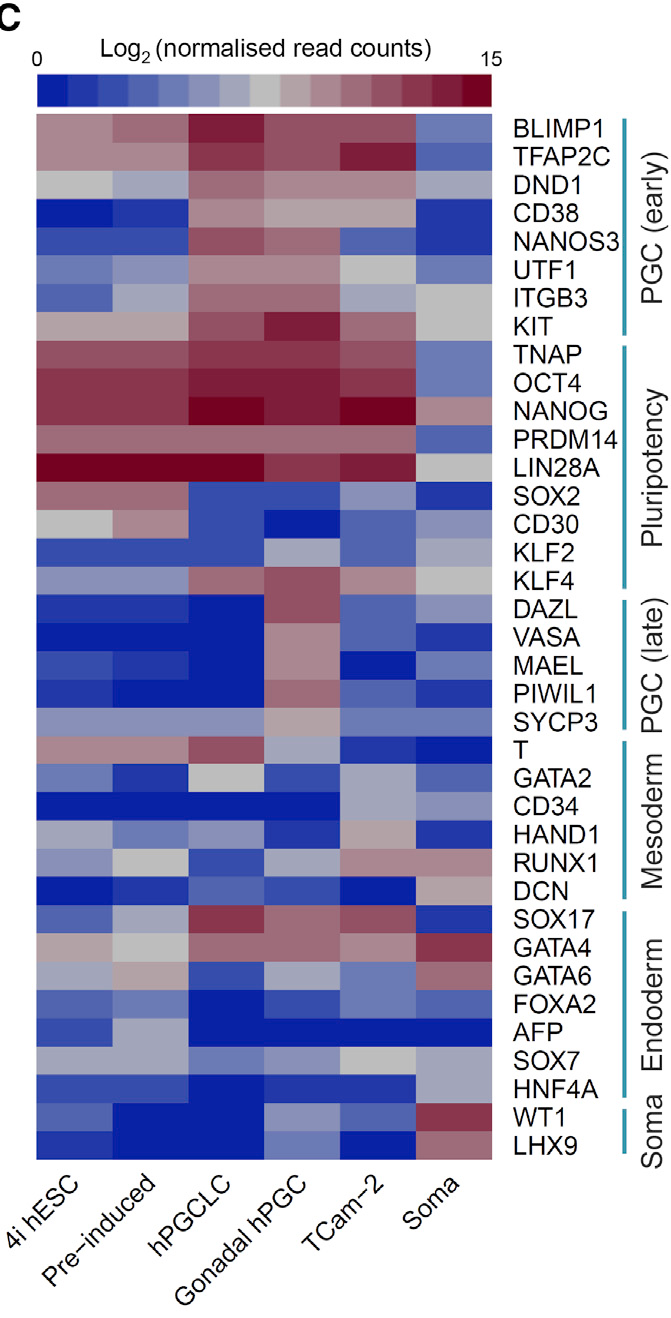SOX17 Is a Critical Specifier of Human Primordial Germ Cell Fate
Naoko Irie, Leehee Weinberger, Walfred W.C. Tang,Toshihiro Kobayashi, Sergey Viukov, Yair S. Manor, Sabine Dietmann, Jacob H. Hanna and M. Azim Surani, 15.01.2015
Abstract
Specification of primordial germ cells (PGCs) marks the beginning of the totipotent state. However, without a tractable experimental model, the mechanism of human PGC (hPGC) specification remains unclear. Here, we demonstrate specification of hPGC-like cells (hPGCLCs) from germline competent pluripotent stem cells. The characteristics of hPGCLCs are consistent with the embryonic hPGCs and a germline seminoma that share a CD38 cell-surface marker, which collectively defines likely progression of the early human germline. Remarkably, SOX17 is the key regulator of hPGC-like fate, whereas BLIMP1 represses endodermal and other somatic genes during specification of hPGCLCs. Notable mechanistic differences between mouse and human PGC specification could be attributed to their divergent embryonic development and pluripotent states, which might affect other early cell-fate decisions. We have established a foundation for future studies on resetting of the epigenome in hPGCLCs and hPGCs for totipotency and the transmission of genetic and epigenetic information.
IRIE, Naoko, et al. SOX17 is a critical specifier of human primordial germ cell fate. Cell, 2015, 160. Jg., Nr. 1-2, S. 253-268.
Publication: https://doi.org/10.1016/j.cell.2014.12.013 Repository: https://www.ncbi.nlm.nih.gov/geo/query/acc.cgi?acc=GSE60138
 Disclaimer
Disclaimer
The publication SOX17 Is a Critical Specifier of Human Primordial Germ Cell Fate by Naoko Irie, Leehee Weinberger, Walfred W.C. Tang,Toshihiro Kobayashi, Sergey Viukov, Yair S. Manor, Sabine Dietmann, Jacob H. Hanna and M. Azim Surani is published under an open access license: https://creativecommons.org/licenses/by/3.0/. Permits to share, copy and redistribute the material in any medium or format and to adapt, remix, transform, and build upon the material for any purpose, even commercially.
Curation by the MFGA team Relevant data sets presented in the publication have been identified. If possible, annotations (title, general information, conditions, processed tissue types and processed cell types) have been added based on information from the publication. Data tables and images that provide a good overview on the publication's findings on the data set have been extracted from the publication and/or supplement. If not stated otherwise, images are depicted with title and description exactly as in the publication. Tables have been adjusted to the MFGA table format. Conducted adjustments are explained in the detailed view of the tables. However, titles and descriptions have been adopted from the publication.
Data set 1: RNA-Seq results for human PGCLCs, PGCs, and TCam-2 Seminoma cells
Transcriptome: Single-cell RNA-Sequencing
Species
| Species |
|---|
| Human |
Tissue Types
| BRENDA tissue ontology | Maturity | Description | Species | Replicates |
|---|---|---|---|---|
| BTO_0000379: embryo | Human | |||
| BTO_0000279: testicular cancer cell | Adult | Tcam-2 cells; Human testicular seminona cell line | Human | 2.0 |
Cell Types
| Cell ontology | Maturity | Description | Species | Replicates | Cells per replicate |
|---|---|---|---|---|---|
| CL_0002322: embryonic stem cell | Embryonic | Human 4i hESC (WIS2: 46XY; WIBR3: 46XX; LIS1, 46XY) | Human | 4 | |
| CL_0002322: embryonic stem cell | Embryonic | human Pre-induced hESC | Human | 2 | |
| Primordial | Human primordial germ cell like cells (hPGCLCs) | Human | 2 | ||
| CL_0000670: primordial germ cell | Primordial | Human primordial germ cells (hPGCs) | Human | 2 | |
| CL_0002371: somatic cell | Embryonic | Gonadal Somatic Cells (from developmental week 7 genital ridge) | Human | 2 | |
| CL_0002322: embryonic stem cell | Embryonic | Human embryonic stem cell line; Conventional hESCs | Human | 2 |
Images

Figure 2D
hPGCLC Shares Transcriptional Profile with Human Embryonic PGCs and TCam-2 Seminoma; (D) Venn diagram illustrates common and differentially expressed genes. Significantly upregulated genes in hPGCLC, gonadal hPGC, and TCam-2 (with log2 (fold change) > 3 and adjusted p value < 0.05 versus gonadal Soma, respectively) were compared. Representative genes that were exclusive to each category are indicated. Text boxes indicate gene ontology biological processes (BP) terms that were significantly enriched as indicated by p values. Asterisk denotes custom categories absent from BP annotation.
Licensed under: https://creativecommons.org/licenses/by/3.0/

Figure 2C
hPGCLC Shares Transcriptional Profile with Human Embryonic PGCs and TCam-2 Seminoma; (C) Heat map of gene expression of key PGC-associated genes (early and late) and of pluripotency, mesoderm, endoderm, and gonadal somatic (Soma) markers.
Licensed under: https://creativecommons.org/licenses/by/3.0/
Results
- Table S1.1: Transcripts expression levels in replicates of indicated samples by RNA-Seq (Log2(normalized read counts)) first
- Table S1.2: Gene list in each category of the Venn diagram in Figure 2D first
- Table S1.3: Gene Ontology (GO) term enrichment analysis peformed by DAVID with genes in each category of Venn diagram in Figure 2D. GO terms shown were with gene count>=5, p value<0.05 and GO Trimming threshold=0.4. first
Data set 2: Comparison of conventional and naive (4i) hESCs
Transcriptome: Single-cell RNA-Sequencing
Species
| Species |
|---|
| Human |
Tissue Types
| BRENDA tissue ontology | Maturity | Description | Species | Replicates |
|---|---|---|---|---|
| BTO_0000379: embryo | Human |
Cell Types
| Cell ontology | Maturity | Description | Species | Replicates | Cells per replicate |
|---|---|---|---|---|---|
| CL_0002322: embryonic stem cell | Embryonic | Human 4i hESC | Human | 4 | |
| CL_0002322: embryonic stem cell | Embryonic | Conventional hESCs | Human | 2 |
Results
- Table S2.2: Differentially expressed genes (Log2(Fold change)>2), p<0.05) between 4i hESC and conventional hESC. first
- Table S2.3: Gene Ontology (GO) term enrichment analysis peformed by DAVID with upegulated genes in 4i hESC (Log2(Fold change)>2), p<0.05). GO terms shown were with p value<0.05 and GO Trimming threshold=0.4. first
- Table S2.4: Gene Ontology (GO) term enrichment analysis peformed by DAVID with upegulated genes in converntional hESC (Log2(Fold change)>2), p<0.05). GO terms shown were with p value<0.05 and GO Trimming threshold=0.4. first
- Table S2.1: Transcripts expression levels in replicates of 4i WIS2 hESC and Conventional WIS2 hESC (log2(normalized read counts)) first
